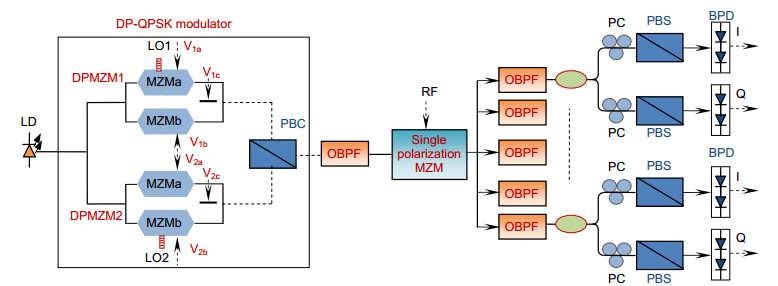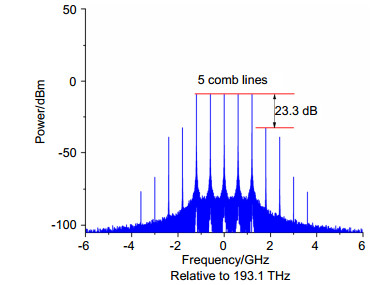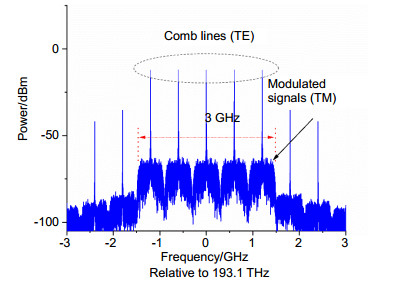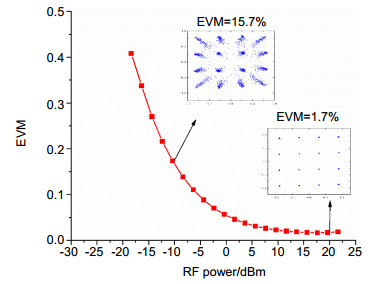An ultra-wideband microwave photonic channelized receiver with zero-IF architecture
-
摘要
信道化接收技术是现代电子战和雷达系统的重要组成部分,是满足其高频段、大带宽、多通道同时接收等需求的核心使能技术。本文提出了一种基于微波光子的零中频接收机,可通过调整光频梳中心频率的方法使之与宽带RF信号组的中心频率相对应,从而实现3 GHz的宽带射频信号的信道化接收,每个子信道带宽为600 MHz且直接解调为I/Q基带信号。

Abstract
Channelized receiving technology is an important part of modern electronic warfare and radar systems. It is a core enabling technology that meets the needs of its high frequency band, large bandwidth, and simultaneous multi-channel reception. In this paper, a zero-IF receiver based on microwave photonic is proposed. The center frequency of the optical frequency comb can be adjusted to correspond to the center frequency of the wideband RF signal group. Therefore, the channelized reception of the 3 GHz wideband RF signal is achieved, and each subchannel has a bandwidth of 600 MHz and is directly demodulated into I/Q baseband signal.
-
Overview

Overview: In modern electronic warfare and radar systems, because the microwave signal received by the receiver has the characteristics of large instantaneous bandwidth, multiple signal types, wide frequency coverage and diversified forms, it is required that the receiver must also have large instantaneous receiving bandwidth, be able to process the multi-frequency and multi-form signals arriving at the same time in real time, and the receiver also needs to have high sensitivity and high resolution. The channelized receiver can divide the received wideband signal into sub-bands of different frequencies, and convert all sub-bands into the same intermediate frequency signal or baseband signal by using down-conversion, which not only greatly reduces the requirements of the system for the ADC but also realizes simultaneous reception of multi-frequency signals. The digital channelized receiver has the advantages of flexible tuning and high precision. However, due to the severe limitation of ADC sampling rate and working bandwidth, it cannot meet the processing requirements of highly intensive ultra wideband signals. Compared with coaxial cable, optical fiber has the advantages of low loss, strong anti electromagnetic interference ability, small volume, light weight and so on. It has become an important transmission medium in the field of communication. The fusion of microwave technology and optical fiber technology has produced a new interdisciplinary subject--microwave photonics. It can flexibly realize the mutual conversion of optical wave and microwave signal, and has a series of advantages such as large instantaneous bandwidth of photonics, wide working frequency band, high isolation, anti electromagnetic interference, etc., which provides a new solution for the research of new channelized receiver.
In this paper, a zero-IF channelized receiver based on microwave photon series is proposed. A scheme for realizing zero-intermediate frequency (IF) channelized receiver using a dual-polarization quadrature phase-shift keying (DP-QPSK) modulator and a narrow-band optical filter is proposed. The channelized system only requires one optical frequency combs to achieve zero-IF multi-channel reception of wideband signals, and the spacing of the optical frequency comb only needs to be equal to the sub-channel width, which is very easy to implement. It is found that using photonic IQ demodulation and balanced detection and reception technology can not only eliminate many disadvantages of the traditional zero-IF receiver, including local oscillator (LO) leakage, DC offset, even-order distortion, and in-phase/quadrature (I/Q) imbalance, but also reduce the bandwidth and sample rate of the analog-to-digital converter (ADC). It is theoretically proved that the RF signal with a bandwidth of 3 GHz can be divided into five sub-channels with a bandwidth of 600 MHz and finally demodulated to I/Q basebands, which is also verified with simulation.
-

-
表 1 各信道之间的串扰测量结果
Table 1. Measured channel crosstalk between all sub-channels
dB Sub-channel 1 2 3 4 5 1 0 25.5 26.5 27.5 28.5 2 25.5 0 25.5 26.5 27.5 3 26.5 25.5 0 25.5 26.5 4 27.5 26.5 25.5 0 25.5 5 28.5 27.5 26.5 25.5 0 -
参考文献
[1] Hirooka T, Nakazawa M. Linear and nonlinear propagation of optical Nyquist pulses in fibers[J]. Optics Express, 2012, 20(18): 19836-19849. doi: 10.1364/OE.20.019836
[2] Wang Q, Huo L, Xing Y F, et al. Ultra-flat optical frequency comb generator using a single-driven dual-parallel Mach-Zehnder modulator[J]. Optics Letters, 2014, 39(10): 3050-3053. doi: 10.1364/OL.39.003050
[3] Wang L X, Zhu N H, Li W, et al. Polarization division multiplexed photonic radio-frequency channelizer using an optical comb[J]. Optics Communications, 2013, 286: 282-287. doi: 10.1016/j.optcom.2012.08.054
[4] Gao Y S, Wen A J, Wu X H, et al. Efficient photonic microwave mixer with compensation of the chromatic dispersion-induced power fading[J]. Journal of Lightwave Technology, 2016, 34(14): 3440-3448. doi: 10.1109/JLT.2016.2555925
[5] Wang J J, Chen M H, Liang Y H, et al. Broadband RF front-end using microwave photonics filter[J]. Optics Express, 2015, 23(2): 839-845. doi: 10.1364/OE.23.000839
[6] Tang Z Z, Pan S L. Image-reject mixer with large suppression of mixing spurs based on a photonic microwave phase shifter[J]. Journal of Lightwave Technology, 2016, 34(20): 4729-4735. doi: 10.1109/JLT.2016.2550180
[7] Yang X W, Xu K, Yin J, et al. Optical frequency comb based multi-band microwave frequency conversion for satellite applications[J]. Optics Express, 2014, 22(1): 869-877. doi: 10.1364/OE.22.000869
[8] Tang Z Z, Zhu D, Pan S L. Coherent optical RF channelizer with large instantaneous bandwidth and large in-band interference suppression[J]. Journal of Lightwave Technology, 2018, 36(19): 4219-4226. doi: 10.1109/JLT.2018.2857500
[9] Gao Y S, Wen A J, Zhang W, et al. Ultra-wideband photonic microwave I/Q mixer for zero-IF receiver[J]. IEEE Transactions on Microwave Theory and Techniques, 2017, 65(11): 4513-4525. doi: 10.1109/TMTT.2017.2695184
[10] Gao Y S, Wen A J, Jiang, W, et al. All-optical and broadband microwave fundamental/sub-harmonic I/Q down-converters[J]. Optics Express, 2018, 26(6): 7336-7350. doi: 10.1364/OE.26.007336
[11] Tang Z Z, Pan S L. A reconfigurable photonic microwave mixer using a 90° optical hybrid[J]. IEEE Transactions on Microwave Theory and Techniques, 2016, 64(9): 3017-3025. doi: 10.1109/TMTT.2016.2594278
[12] Jiang W, Zhao S H, Tan Q G, et al. Wideband photonic microwave channelization and image-reject down-conversion[J]. Optics Communications, 2019, 445: 41-49. doi: 10.1016/j.optcom.2019.04.013
-
访问统计


 E-mail Alert
E-mail Alert RSS
RSS

 下载:
下载:







